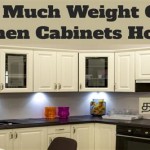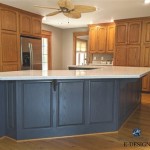Textured Kitchen Cabinets: A Guide to Their Essential Aspects
When it comes to kitchen design, cabinets play a crucial role in shaping the overall aesthetic and functionality of the space. Textured kitchen cabinets, with their rich details and tactile qualities, have emerged as a popular choice among homeowners seeking to add character and depth to their kitchens.
In this article, we delve into the essential aspects of textured kitchen cabinets, exploring their unique features, materials, and the various techniques used to achieve different textures. We also discuss the advantages and considerations associated with opting for textured cabinetry, providing a comprehensive guide to help you make informed decisions.
Unique Features of Textured Kitchen Cabinets
Textured kitchen cabinets distinguish themselves from smooth-surfaced cabinetry by incorporating visual and tactile textures that enhance the overall design of the kitchen.
Their textured surfaces create a dynamic play of light and shadow, adding depth and visual interest to the space. The tactile qualities of textured cabinets provide a unique sensory experience, inviting users to interact with the cabinetry on a more personal level.
Materials Used in Textured Kitchen Cabinets
Various materials can be employed to create textured kitchen cabinets, each offering its own distinct characteristics and advantages:
- Wood: Wood is a classic choice for kitchen cabinets, and textured wood cabinets can be achieved through techniques like wire brushing, sandblasting, or carving.
- Laminate: Laminate is a durable and cost-effective option for textured cabinetry. It is available in a wide range of textures, including woodgrains, stone patterns, and metallic finishes.
- Thermofoil: Thermofoil is a vinyl material that is vacuum-sealed onto the cabinet surface. It offers a seamless, textured finish that is resistant to moisture and wear.
- Acrylic: Acrylic is a high-gloss material that can be textured to achieve a variety of effects, including shimmering metallics, woodgrains, and abstract patterns.
Techniques for Creating Texture
The techniques used to create texture on kitchen cabinets range from traditional methods to innovative technologies:
- Brushing: Wire brushing, sandblasting, and other brushing techniques create a distressed or rustic finish.
- Carving: Hand-carving or CNC carving can produce intricate patterns and motifs, adding depth and detail to the cabinet surface.
- Embossing: Embossing involves pressing a textured pattern onto the cabinet surface, creating a raised or sunken effect.
- Textured Laminates: Laminates are available in a wide range of textured finishes, from woodgrains to stone patterns.
- 3D Printing: Advanced 3D printing technologies allow for the creation of complex and highly textured cabinet surfaces.
Advantages of Textured Kitchen Cabinets
Opting for textured kitchen cabinets offers several advantages:
- Visual Interest: Textured cabinets add visual depth and interest to kitchen spaces, creating a more dynamic and inviting atmosphere.
- Tactile Appeal: The textured surfaces provide a unique sensory experience, adding a playful and tactile element to the kitchen.
- Durability: Textured surfaces can be more durable than smooth surfaces, as they hide minor scratches and imperfections better.
- Style Versatility: Textured cabinets come in various styles, from rustic to modern, allowing them to complement different kitchen designs.
Considerations for Textured Kitchen Cabinets
While textured kitchen cabinets offer numerous benefits, there are also some considerations to keep in mind:
- Cleaning: Textured surfaces may require more frequent cleaning to remove dust and dirt accumulation in crevices.
- Cost: Textured cabinets can be more expensive than smooth-surfaced cabinetry due to the additional labor and materials involved.
- Maintenance: Depending on the material and texture, textured cabinets may require more frequent maintenance to preserve their appearance.
- Style Implications: The texture of the cabinets should complement the overall kitchen design style to create a cohesive and harmonious space.
Conclusion
Textured kitchen cabinets offer a unique and visually stunning way to transform the heart of your home. By understanding the essential aspects of textured cabinetry, from the materials used to the techniques employed, you can make informed decisions to create a kitchen that perfectly reflects your style and needs. Embrace the richness and depth that textured kitchen cabinets bring, and enjoy a space that is both functional and aesthetically captivating.

Modern Textured Laminate Contemporary Kitchen Masterbrand

Gray Shaker Frameless Style

White Textured Kitchen Cabinets Studio Haus

White Textured Kitchen Cabinets Studio Haus

Textured Finish Cabinets

Modern Kitchen With Archicrete And Charred Textured Melamine Finishes New York By Ultracraft Cabinetry Houzz

Discover Duraform Cabinets Waypoint Living Spaces

Modern Textured Laminate Contemporary Kitchen Masterbrand

Modern Black And Woodgrain Textured Feather Kitchen Cabinets

Theril Cabinets Hanover
Related Posts








